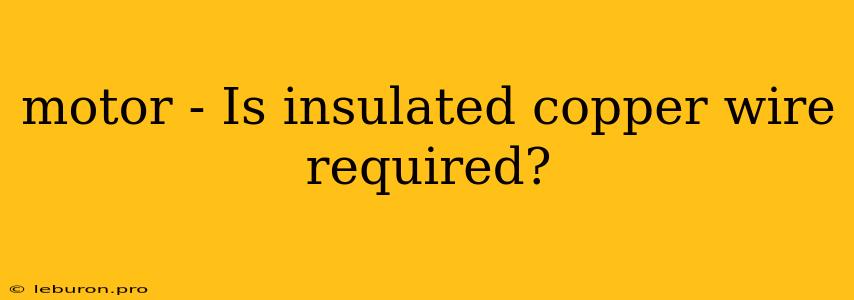The construction of a motor involves a complex interplay of components, each serving a specific purpose. One crucial element is the winding, typically made of copper wire. But is insulated copper wire absolutely necessary? This question often arises, particularly for those venturing into DIY motor projects or seeking to understand the intricacies of motor design. While bare copper wire might seem like a cost-effective alternative, the use of insulated copper wire is essential for safe and efficient motor operation. This article will delve into the reasons why insulated copper wire is vital, exploring its role in preventing short circuits, enhancing insulation resistance, and ensuring the longevity of the motor.
The Importance of Insulation in Motor Winding
A motor's winding is essentially a series of interconnected coils that generate the magnetic field necessary for rotation. The winding is made up of a large number of turns of copper wire, and these turns are often tightly packed together. The flow of electricity through the winding creates a magnetic field, which in turn interacts with the magnetic field of the rotor, leading to the motor's rotation.
Preventing Short Circuits: The Crucial Role of Insulation
Imagine a motor winding where the bare copper wires are in direct contact with each other. This scenario would create a short circuit, allowing electricity to flow directly between the wires, bypassing the intended path and potentially causing significant damage. The high current flow generated by a short circuit could overheat the winding, melting the insulation and potentially causing the motor to catch fire. Insulated copper wire effectively prevents this by providing a protective barrier between the individual wires, ensuring that electricity flows only through the intended path.
Insulation Resistance: A Measure of Protection
The effectiveness of the insulation in a motor winding is measured by its insulation resistance. This refers to the resistance to the flow of electricity between the winding and other components, such as the motor frame or the surrounding air. A high insulation resistance indicates that the insulation is effective in preventing electrical leakage, ensuring safe and efficient operation.
Types of Insulation for Motor Wire
The type of insulation used for motor wire varies depending on the application and the operating environment. Some common insulation types include:
- Enameled wire: This type of wire has a thin layer of enamel coating applied directly to the copper wire. It is commonly used in motors operating at lower temperatures and where space is limited.
- Polyvinyl chloride (PVC) insulated wire: This type of wire is covered with a layer of PVC, offering greater durability and resistance to moisture and abrasion. It is widely used in general-purpose motors.
- Silicone-coated wire: This type of wire is coated with a silicone-based insulation, providing excellent heat resistance and flexibility. It is ideal for applications where high operating temperatures are expected.
Maintaining Insulation Integrity for Optimal Performance
Over time, the insulation of motor wire can degrade due to factors like heat, moisture, and mechanical stress. This degradation can lead to reduced insulation resistance, increasing the risk of short circuits and motor failures. To ensure the long-term performance and safety of a motor, it is crucial to maintain the integrity of the insulation. This includes using appropriate insulation types, operating the motor within its specified temperature range, and avoiding excessive moisture exposure.
Conclusion
In conclusion, insulated copper wire is indispensable for the safe and efficient operation of motors. Its insulation provides a protective barrier, preventing short circuits and ensuring that electricity flows only through the intended path. The insulation resistance of motor wire is a crucial indicator of its effectiveness in preventing electrical leakage. By using appropriate insulation types, operating the motor within its specified limits, and maintaining the integrity of the insulation, one can ensure the long-term performance and reliability of the motor. Remember, using bare copper wire in a motor winding can lead to catastrophic failures, making insulated copper wire the preferred choice for motor construction.
